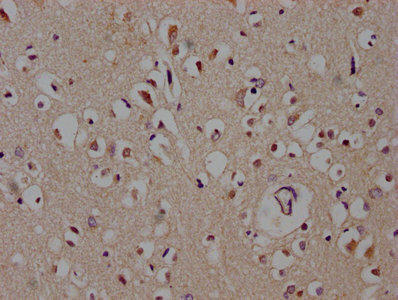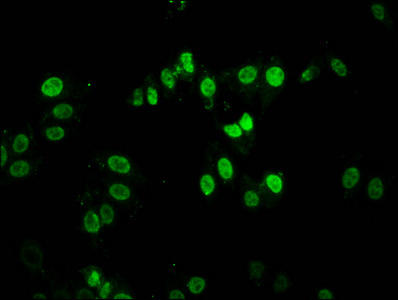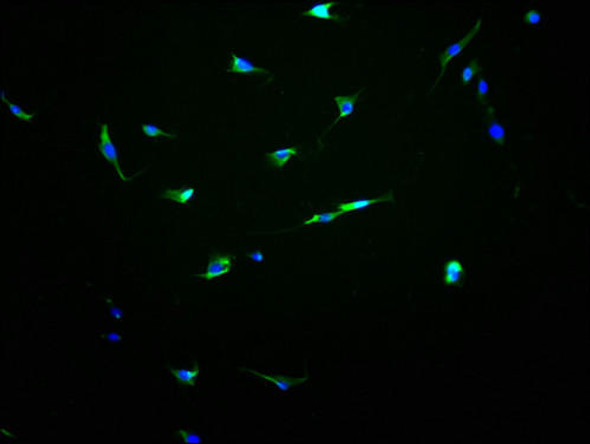Description
| Antibody Name: | DACT1 Antibody (PACO60360) |
| Antibody SKU: | PACO60360 |
| Size: | 50ug |
| Host Species: | Rabbit |
| Tested Applications: | ELISA, IHC, IF |
| Recommended Dilutions: | ELISA:1:2000-1:10000, IHC:1:500-1:1000, IF:1:50-1:200 |
| Species Reactivity: | Human |
| Immunogen: | Recombinant Human Dapper homolog 1 protein (410-525AA) |
| Form: | Liquid |
| Storage Buffer: | Preservative: 0.03% Proclin 300 Constituents: 50% Glycerol, 0.01M PBS, pH 7.4 |
| Purification Method: | >95%, Protein G purified |
| Clonality: | Polyclonal |
| Isotype: | IgG |
| Conjugate: | Non-conjugated |
 | IHC image of PACO60360 diluted at 1:600 and staining in paraffin-embedded human brain tissue performed on a Leica BondTM system. After dewaxing and hydration, antigen retrieval was mediated by high pressure in a citrate buffer (pH 6.0). Section was blocked with 10% normal goat serum 30min at RT. Then primary antibody (1% BSA) was incubated at 4°C overnight. The primary is detected by a biotinylated secondary antibody and visualized using an HRP conjugated SP system. |
 | Immunofluorescence staining of HepG2 cells with PACO60360 at 1:100, counter-stained with DAPI. The cells were fixed in 4% formaldehyde, permeabilized tissue using 0.2% Triton X-100 and blocked in 10% normal Goat Serum. The cells were then incubated with the antibody overnight at 4°C.The secondary antibody was Alexa Fluor 488-congugated AffiniPure Goat Anti-Rabbit IgG(H+L). |
| Background: | Involved in regulation of intracellular signaling pathways during development. Specifically thought to play a role in canonical and/or non-canonical Wnt signaling pathways through interaction with DSH (Dishevelled) family proteins. The activation/inhibition of Wnt signaling may depend on the phosphorylation status. Proposed to regulate the degradation of CTNNB1/beta-catenin, thereby modulating the transcriptional activation of target genes of the Wnt signaling pathway. Its function in stabilizing CTNNB1 may involve inhibition of GSK3B activity. Promotes the membrane localization of CTNNB1. The cytoplasmic form can induce DVL2 degradation via a lysosome-dependent mechanism; the function is inhibited by PKA-induced binding to 14-3-3 proteins, such as YWHAB. Seems to be involved in morphogenesis at the primitive streak by regulating VANGL2 and DVL2; the function seems to be independent of canonical Wnt signaling and rather involves the non-canonical Wnt/planar cell polarity (PCP) pathway (By similarity). The nuclear form may prevent the formation of LEF1:CTNNB1 complex and recruit HDAC1 to LEF1 at target gene promoters to repress transcription thus antagonizing Wnt signaling. May be involved in positive regulation of fat cell differentiation. During neuronal differentiation may be involved in excitatory synapse organization, and dendrite formation and establishment of spines. |
| Synonyms: | Dapper homolog 1 (hDPR1) (Dapper antagonist of catenin 1) (Hepatocellular carcinoma novel gene 3 protein), DACT1, DPR1 HNG3 |
| UniProt Protein Function: | Involved in regulation of intracellular signaling pathways during development. Specifically thought to play a role in canonical and/or non-canonical Wnt signaling pathways through interaction with DSH (Dishevelled) family proteins. The activation/inhibition of Wnt signaling may depend on the phosphorylation status. Proposed to regulate the degradation of CTNNB1/beta-catenin, thereby modulating the transcriptional activation of target genes of the Wnt signaling pathway. Its function in stabilizing CTNNB1 may involve inhibition of GSK3B activity. Promotes the membrane localization of CTNNB1. The cytoplasmic form can induce DVL2 degradation via a lysosome-dependent mechanism; the function is inhibited by PKA-induced binding to 14-3-3 proteins, such as YWHAB. Seems to be involved in morphogenesis at the primitive streak by regulating VANGL2 and DVL2; the function seems to be independent of canonical Wnt signaling and rather involves the non-canonical Wnt/planar cell polarity (PCP) pathway (). The nuclear form may prevent the formation of LEF1:CTNNB1 complex and recruit HDAC1 to LEF1 at target gene promoters to repress transcription thus antagonizing Wnt signaling. May be involved in positive regulation of fat cell differentiation. During neuronal differentiation may be involved in excitatory synapse organization, and dendrite formation and establishment of spines. |
| UniProt Protein Details: | |
| NCBI Summary: | The protein encoded by this gene belongs to the dapper family, characterized by the presence of PDZ-binding motif at the C-terminus. It interacts with, and positively regulates dishevelled-mediated signaling pathways during development. Depletion of this mRNA from xenopus embryos resulted in loss of notochord and head structures, and mice lacking this gene died shortly after birth from severe posterior malformations. Alternatively spliced transcript variants have been found for this gene. [provided by RefSeq, Jan 2012] |
| UniProt Code: | Q9NYF0 |
| NCBI GenInfo Identifier: | 118498364 |
| NCBI Gene ID: | 51339 |
| NCBI Accession: | NP_001072988.1 |
| UniProt Secondary Accession: | Q9NYF0,Q86TY0, A8MYJ2 |
| UniProt Related Accession: | Q9NYF0 |
| Molecular Weight: | 86,212 Da |
| NCBI Full Name: | dapper homolog 1 isoform 2 |
| NCBI Synonym Full Names: | dishevelled binding antagonist of beta catenin 1 |
| NCBI Official Symbol: | DACT1 |
| NCBI Official Synonym Symbols: | DPR1; TBS2; FRODO; HDPR1; DAPPER; THYEX3; DAPPER1 |
| NCBI Protein Information: | dapper homolog 1 |
| UniProt Protein Name: | Dapper homolog 1 |
| UniProt Synonym Protein Names: | Dapper antagonist of catenin 1; Hepatocellular carcinoma novel gene 3 protein |
| Protein Family: | Dapper |
| UniProt Gene Name: | DACT1 |
| UniProt Entry Name: |






